Annotated Bibliography: Professional Skills for ICT and 3D Printing
VerifiedAdded on 2021/06/15
|9
|1160
|78
Annotated Bibliography
AI Summary
This annotated bibliography focuses on professional skills related to Information and Communication Technology (ICT), specifically examining the applications and implications of 3D printing. It includes annotations of research articles discussing the mapping of additive manufacturing (AM) products and services using 3D printing technology, as well as the medical applications of 3D printing and its impact on healthcare. The annotations provide summaries of the articles' scopes, methodologies, and key findings, along with recommendations for further research and application. The bibliography highlights the potential of 3D printing to revolutionize various fields and emphasizes the need for continued research and development in this area. Desklib provides access to similar solved assignments.

1
Running head: PROFESSIONAL SKILLS FOR INFORMATION AND COMMUNICATION
TECHNOLOGY
Professional skills for Information and Communication Technology
Name of Student
Name of University
Author Note
Running head: PROFESSIONAL SKILLS FOR INFORMATION AND COMMUNICATION
TECHNOLOGY
Professional skills for Information and Communication Technology
Name of Student
Name of University
Author Note
Paraphrase This Document
Need a fresh take? Get an instant paraphrase of this document with our AI Paraphraser
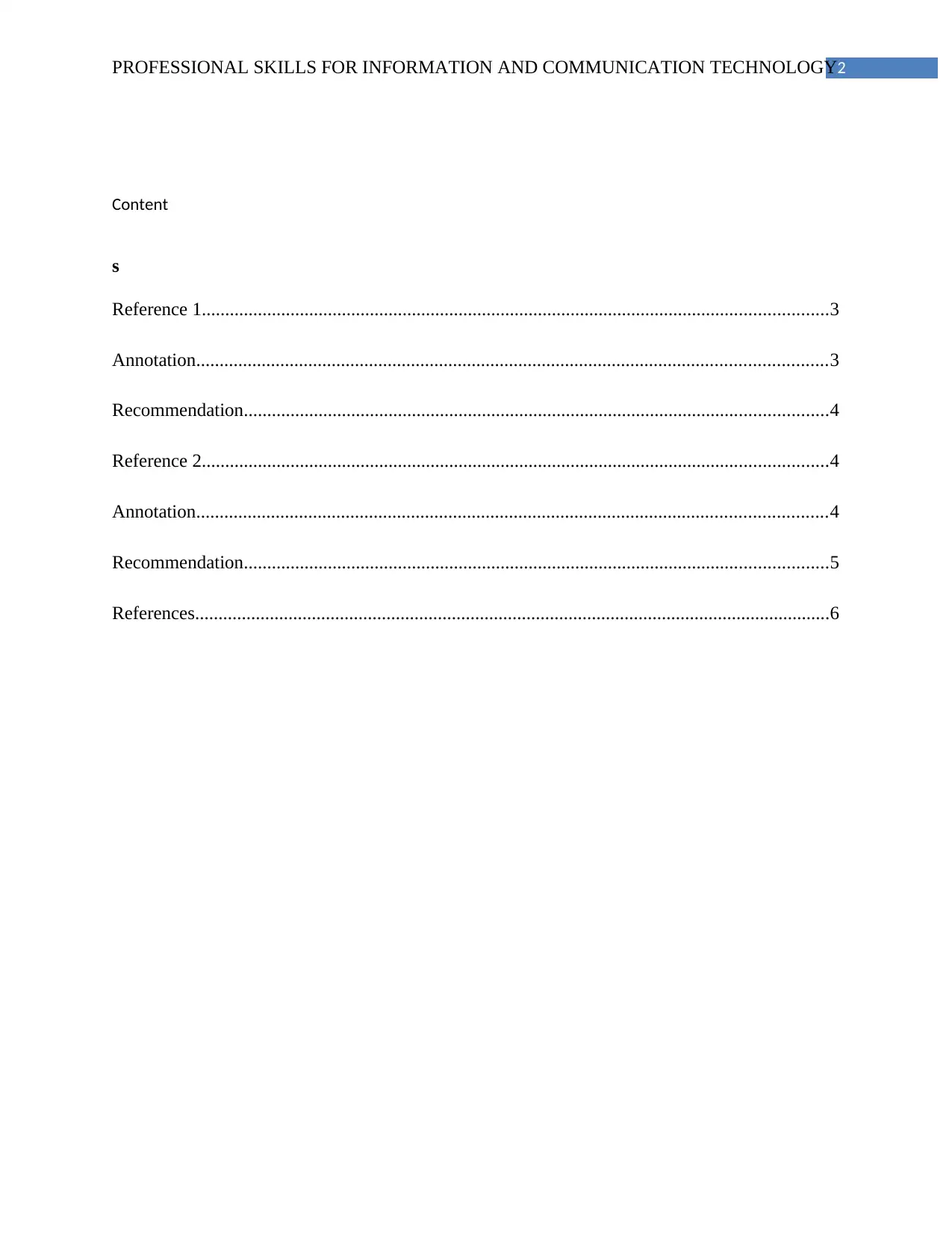
2PROFESSIONAL SKILLS FOR INFORMATION AND COMMUNICATION TECHNOLOGY
Content
s
Reference 1......................................................................................................................................3
Annotation.......................................................................................................................................3
Recommendation.............................................................................................................................4
Reference 2......................................................................................................................................4
Annotation.......................................................................................................................................4
Recommendation.............................................................................................................................5
References........................................................................................................................................6
Content
s
Reference 1......................................................................................................................................3
Annotation.......................................................................................................................................3
Recommendation.............................................................................................................................4
Reference 2......................................................................................................................................4
Annotation.......................................................................................................................................4
Recommendation.............................................................................................................................5
References........................................................................................................................................6
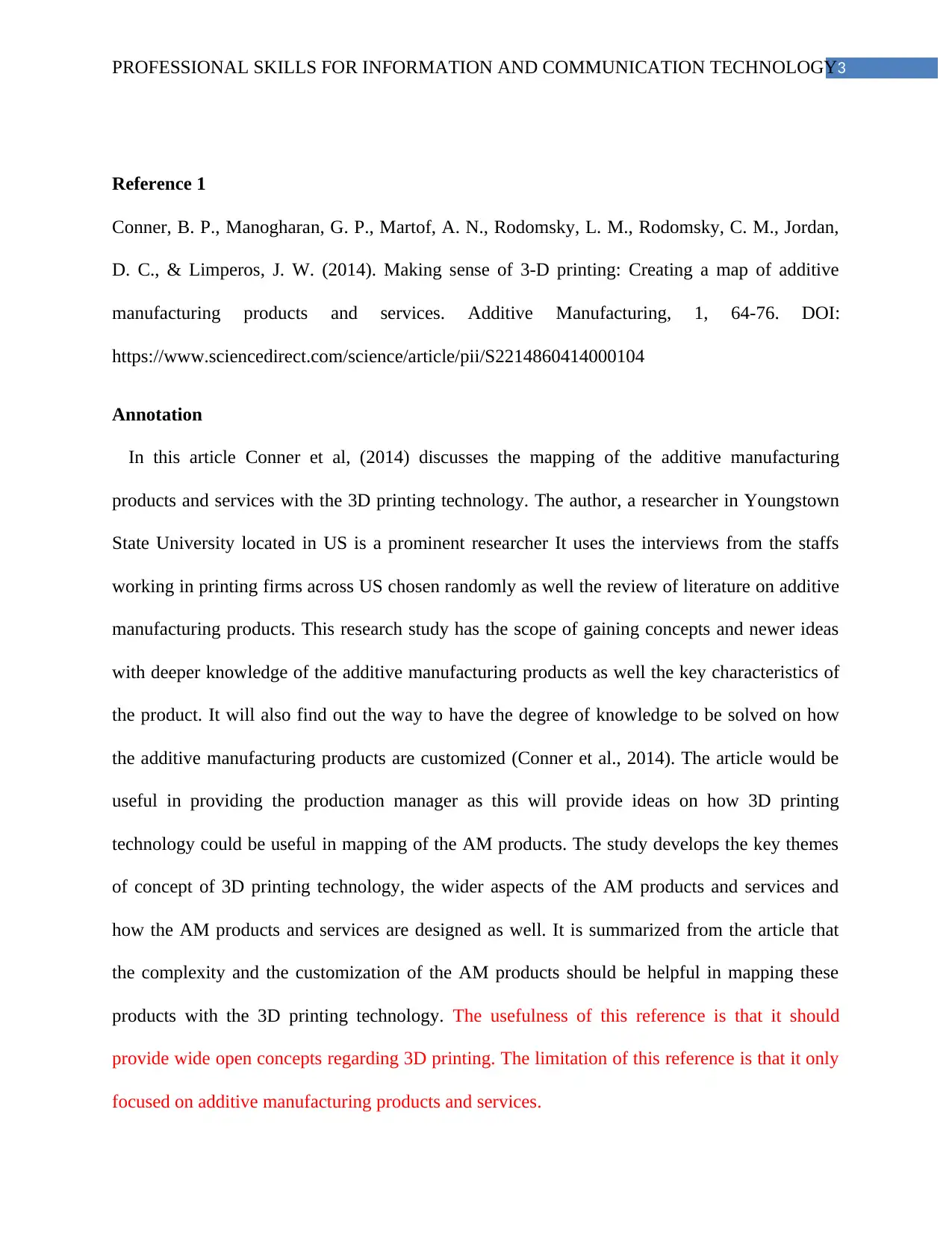
3PROFESSIONAL SKILLS FOR INFORMATION AND COMMUNICATION TECHNOLOGY
Reference 1
Conner, B. P., Manogharan, G. P., Martof, A. N., Rodomsky, L. M., Rodomsky, C. M., Jordan,
D. C., & Limperos, J. W. (2014). Making sense of 3-D printing: Creating a map of additive
manufacturing products and services. Additive Manufacturing, 1, 64-76. DOI:
https://www.sciencedirect.com/science/article/pii/S2214860414000104
Annotation
In this article Conner et al, (2014) discusses the mapping of the additive manufacturing
products and services with the 3D printing technology. The author, a researcher in Youngstown
State University located in US is a prominent researcher It uses the interviews from the staffs
working in printing firms across US chosen randomly as well the review of literature on additive
manufacturing products. This research study has the scope of gaining concepts and newer ideas
with deeper knowledge of the additive manufacturing products as well the key characteristics of
the product. It will also find out the way to have the degree of knowledge to be solved on how
the additive manufacturing products are customized (Conner et al., 2014). The article would be
useful in providing the production manager as this will provide ideas on how 3D printing
technology could be useful in mapping of the AM products. The study develops the key themes
of concept of 3D printing technology, the wider aspects of the AM products and services and
how the AM products and services are designed as well. It is summarized from the article that
the complexity and the customization of the AM products should be helpful in mapping these
products with the 3D printing technology. The usefulness of this reference is that it should
provide wide open concepts regarding 3D printing. The limitation of this reference is that it only
focused on additive manufacturing products and services.
Reference 1
Conner, B. P., Manogharan, G. P., Martof, A. N., Rodomsky, L. M., Rodomsky, C. M., Jordan,
D. C., & Limperos, J. W. (2014). Making sense of 3-D printing: Creating a map of additive
manufacturing products and services. Additive Manufacturing, 1, 64-76. DOI:
https://www.sciencedirect.com/science/article/pii/S2214860414000104
Annotation
In this article Conner et al, (2014) discusses the mapping of the additive manufacturing
products and services with the 3D printing technology. The author, a researcher in Youngstown
State University located in US is a prominent researcher It uses the interviews from the staffs
working in printing firms across US chosen randomly as well the review of literature on additive
manufacturing products. This research study has the scope of gaining concepts and newer ideas
with deeper knowledge of the additive manufacturing products as well the key characteristics of
the product. It will also find out the way to have the degree of knowledge to be solved on how
the additive manufacturing products are customized (Conner et al., 2014). The article would be
useful in providing the production manager as this will provide ideas on how 3D printing
technology could be useful in mapping of the AM products. The study develops the key themes
of concept of 3D printing technology, the wider aspects of the AM products and services and
how the AM products and services are designed as well. It is summarized from the article that
the complexity and the customization of the AM products should be helpful in mapping these
products with the 3D printing technology. The usefulness of this reference is that it should
provide wide open concepts regarding 3D printing. The limitation of this reference is that it only
focused on additive manufacturing products and services.
⊘ This is a preview!⊘
Do you want full access?
Subscribe today to unlock all pages.

Trusted by 1+ million students worldwide
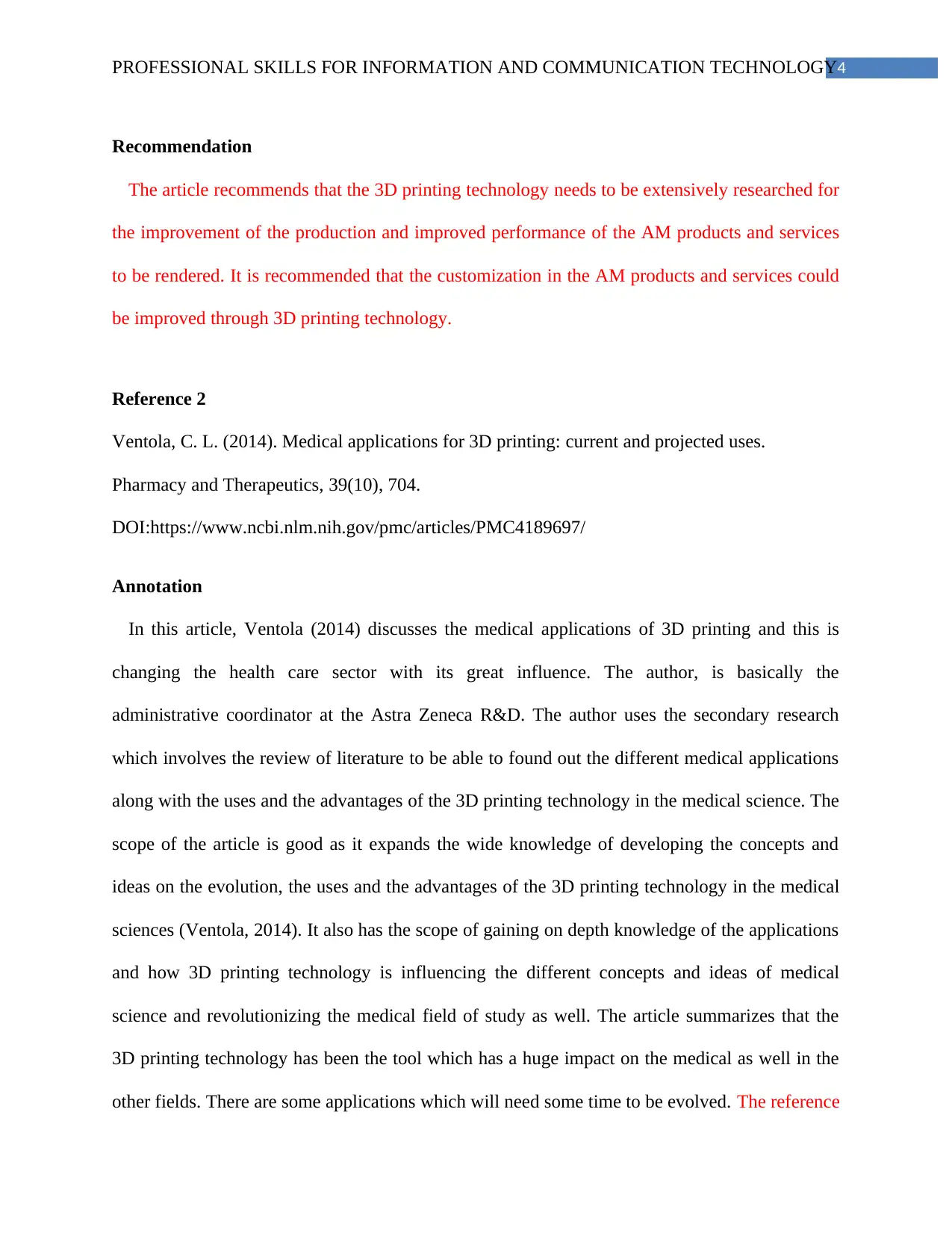
4PROFESSIONAL SKILLS FOR INFORMATION AND COMMUNICATION TECHNOLOGY
Recommendation
The article recommends that the 3D printing technology needs to be extensively researched for
the improvement of the production and improved performance of the AM products and services
to be rendered. It is recommended that the customization in the AM products and services could
be improved through 3D printing technology.
Reference 2
Ventola, C. L. (2014). Medical applications for 3D printing: current and projected uses.
Pharmacy and Therapeutics, 39(10), 704.
DOI:https://www.ncbi.nlm.nih.gov/pmc/articles/PMC4189697/
Annotation
In this article, Ventola (2014) discusses the medical applications of 3D printing and this is
changing the health care sector with its great influence. The author, is basically the
administrative coordinator at the Astra Zeneca R&D. The author uses the secondary research
which involves the review of literature to be able to found out the different medical applications
along with the uses and the advantages of the 3D printing technology in the medical science. The
scope of the article is good as it expands the wide knowledge of developing the concepts and
ideas on the evolution, the uses and the advantages of the 3D printing technology in the medical
sciences (Ventola, 2014). It also has the scope of gaining on depth knowledge of the applications
and how 3D printing technology is influencing the different concepts and ideas of medical
science and revolutionizing the medical field of study as well. The article summarizes that the
3D printing technology has been the tool which has a huge impact on the medical as well in the
other fields. There are some applications which will need some time to be evolved. The reference
Recommendation
The article recommends that the 3D printing technology needs to be extensively researched for
the improvement of the production and improved performance of the AM products and services
to be rendered. It is recommended that the customization in the AM products and services could
be improved through 3D printing technology.
Reference 2
Ventola, C. L. (2014). Medical applications for 3D printing: current and projected uses.
Pharmacy and Therapeutics, 39(10), 704.
DOI:https://www.ncbi.nlm.nih.gov/pmc/articles/PMC4189697/
Annotation
In this article, Ventola (2014) discusses the medical applications of 3D printing and this is
changing the health care sector with its great influence. The author, is basically the
administrative coordinator at the Astra Zeneca R&D. The author uses the secondary research
which involves the review of literature to be able to found out the different medical applications
along with the uses and the advantages of the 3D printing technology in the medical science. The
scope of the article is good as it expands the wide knowledge of developing the concepts and
ideas on the evolution, the uses and the advantages of the 3D printing technology in the medical
sciences (Ventola, 2014). It also has the scope of gaining on depth knowledge of the applications
and how 3D printing technology is influencing the different concepts and ideas of medical
science and revolutionizing the medical field of study as well. The article summarizes that the
3D printing technology has been the tool which has a huge impact on the medical as well in the
other fields. There are some applications which will need some time to be evolved. The reference
Paraphrase This Document
Need a fresh take? Get an instant paraphrase of this document with our AI Paraphraser
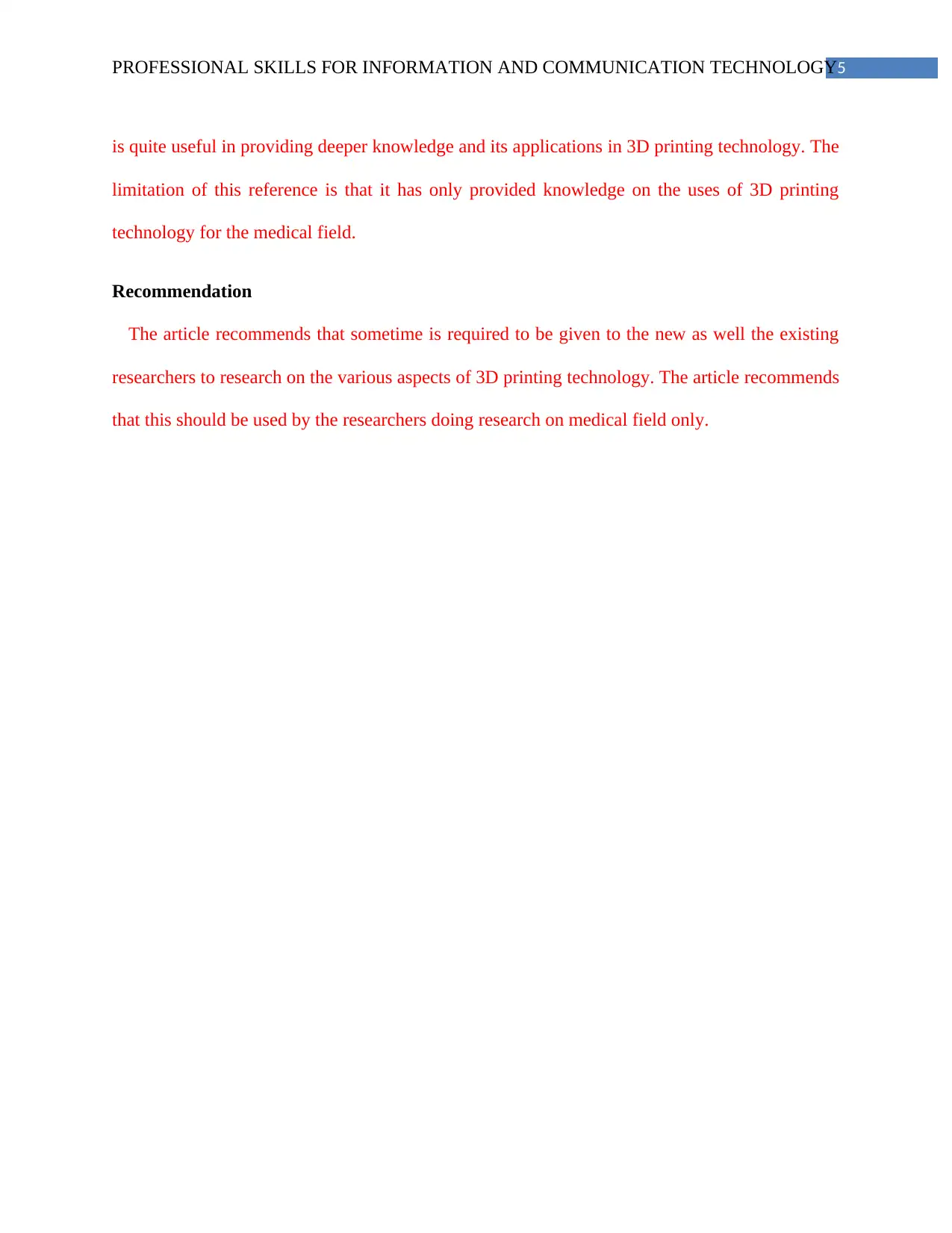
5PROFESSIONAL SKILLS FOR INFORMATION AND COMMUNICATION TECHNOLOGY
is quite useful in providing deeper knowledge and its applications in 3D printing technology. The
limitation of this reference is that it has only provided knowledge on the uses of 3D printing
technology for the medical field.
Recommendation
The article recommends that sometime is required to be given to the new as well the existing
researchers to research on the various aspects of 3D printing technology. The article recommends
that this should be used by the researchers doing research on medical field only.
is quite useful in providing deeper knowledge and its applications in 3D printing technology. The
limitation of this reference is that it has only provided knowledge on the uses of 3D printing
technology for the medical field.
Recommendation
The article recommends that sometime is required to be given to the new as well the existing
researchers to research on the various aspects of 3D printing technology. The article recommends
that this should be used by the researchers doing research on medical field only.
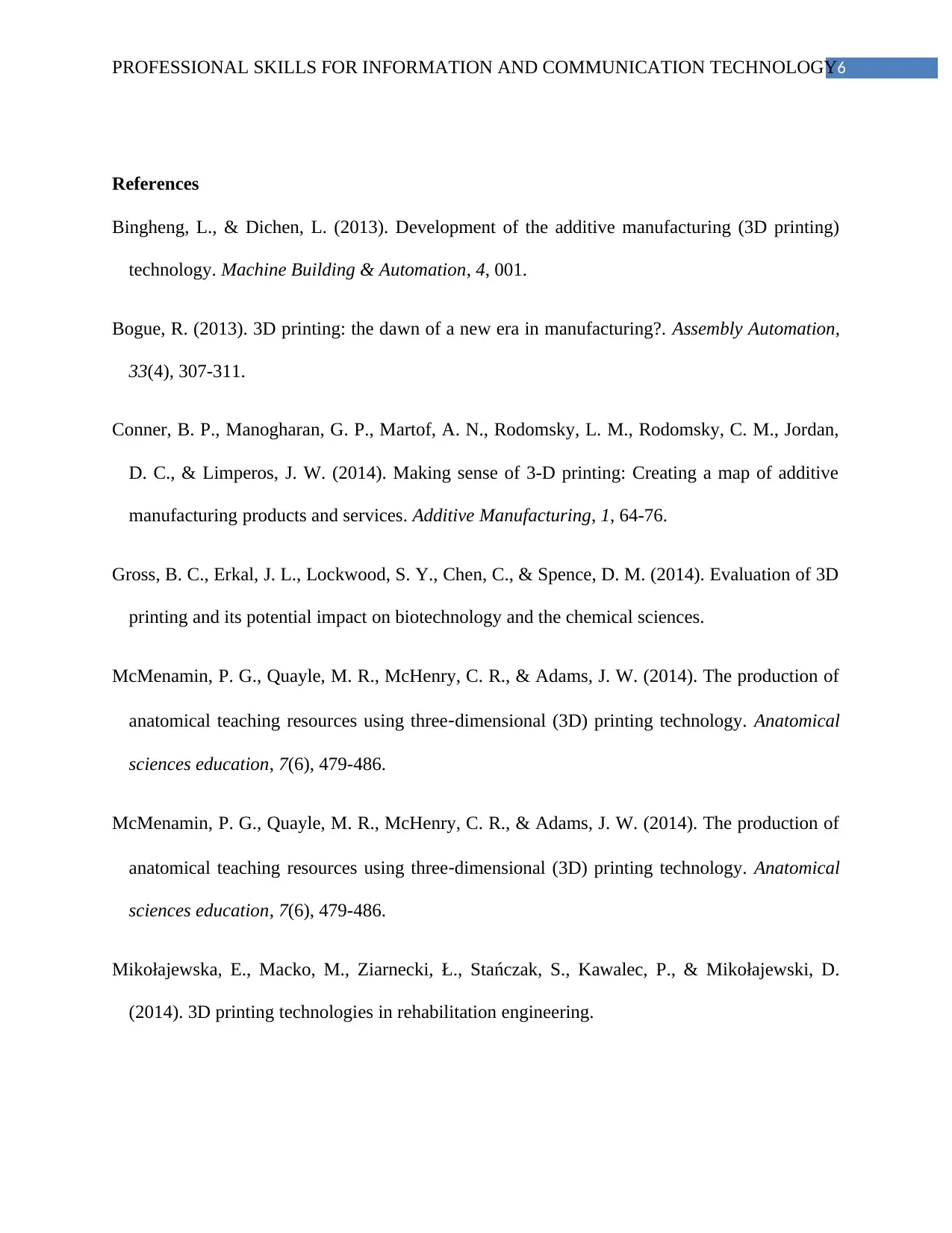
6PROFESSIONAL SKILLS FOR INFORMATION AND COMMUNICATION TECHNOLOGY
References
Bingheng, L., & Dichen, L. (2013). Development of the additive manufacturing (3D printing)
technology. Machine Building & Automation, 4, 001.
Bogue, R. (2013). 3D printing: the dawn of a new era in manufacturing?. Assembly Automation,
33(4), 307-311.
Conner, B. P., Manogharan, G. P., Martof, A. N., Rodomsky, L. M., Rodomsky, C. M., Jordan,
D. C., & Limperos, J. W. (2014). Making sense of 3-D printing: Creating a map of additive
manufacturing products and services. Additive Manufacturing, 1, 64-76.
Gross, B. C., Erkal, J. L., Lockwood, S. Y., Chen, C., & Spence, D. M. (2014). Evaluation of 3D
printing and its potential impact on biotechnology and the chemical sciences.
McMenamin, P. G., Quayle, M. R., McHenry, C. R., & Adams, J. W. (2014). The production of
anatomical teaching resources using three‐dimensional (3D) printing technology. Anatomical
sciences education, 7(6), 479-486.
McMenamin, P. G., Quayle, M. R., McHenry, C. R., & Adams, J. W. (2014). The production of
anatomical teaching resources using three‐dimensional (3D) printing technology. Anatomical
sciences education, 7(6), 479-486.
Mikołajewska, E., Macko, M., Ziarnecki, Ł., Stańczak, S., Kawalec, P., & Mikołajewski, D.
(2014). 3D printing technologies in rehabilitation engineering.
References
Bingheng, L., & Dichen, L. (2013). Development of the additive manufacturing (3D printing)
technology. Machine Building & Automation, 4, 001.
Bogue, R. (2013). 3D printing: the dawn of a new era in manufacturing?. Assembly Automation,
33(4), 307-311.
Conner, B. P., Manogharan, G. P., Martof, A. N., Rodomsky, L. M., Rodomsky, C. M., Jordan,
D. C., & Limperos, J. W. (2014). Making sense of 3-D printing: Creating a map of additive
manufacturing products and services. Additive Manufacturing, 1, 64-76.
Gross, B. C., Erkal, J. L., Lockwood, S. Y., Chen, C., & Spence, D. M. (2014). Evaluation of 3D
printing and its potential impact on biotechnology and the chemical sciences.
McMenamin, P. G., Quayle, M. R., McHenry, C. R., & Adams, J. W. (2014). The production of
anatomical teaching resources using three‐dimensional (3D) printing technology. Anatomical
sciences education, 7(6), 479-486.
McMenamin, P. G., Quayle, M. R., McHenry, C. R., & Adams, J. W. (2014). The production of
anatomical teaching resources using three‐dimensional (3D) printing technology. Anatomical
sciences education, 7(6), 479-486.
Mikołajewska, E., Macko, M., Ziarnecki, Ł., Stańczak, S., Kawalec, P., & Mikołajewski, D.
(2014). 3D printing technologies in rehabilitation engineering.
⊘ This is a preview!⊘
Do you want full access?
Subscribe today to unlock all pages.

Trusted by 1+ million students worldwide
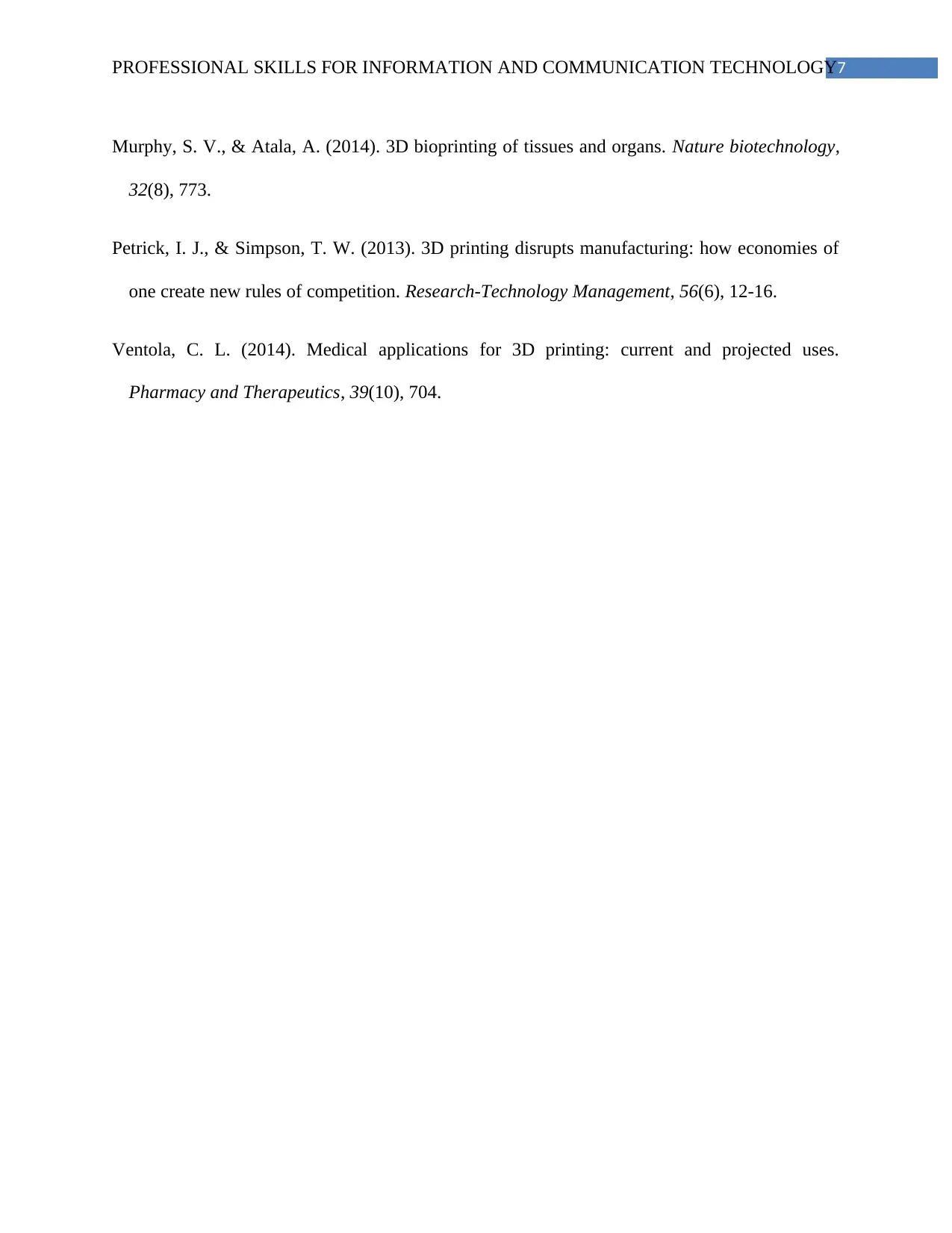
7PROFESSIONAL SKILLS FOR INFORMATION AND COMMUNICATION TECHNOLOGY
Murphy, S. V., & Atala, A. (2014). 3D bioprinting of tissues and organs. Nature biotechnology,
32(8), 773.
Petrick, I. J., & Simpson, T. W. (2013). 3D printing disrupts manufacturing: how economies of
one create new rules of competition. Research-Technology Management, 56(6), 12-16.
Ventola, C. L. (2014). Medical applications for 3D printing: current and projected uses.
Pharmacy and Therapeutics, 39(10), 704.
Murphy, S. V., & Atala, A. (2014). 3D bioprinting of tissues and organs. Nature biotechnology,
32(8), 773.
Petrick, I. J., & Simpson, T. W. (2013). 3D printing disrupts manufacturing: how economies of
one create new rules of competition. Research-Technology Management, 56(6), 12-16.
Ventola, C. L. (2014). Medical applications for 3D printing: current and projected uses.
Pharmacy and Therapeutics, 39(10), 704.
Paraphrase This Document
Need a fresh take? Get an instant paraphrase of this document with our AI Paraphraser

8PROFESSIONAL SKILLS FOR INFORMATION AND COMMUNICATION TECHNOLOGY

9PROFESSIONAL SKILLS FOR INFORMATION AND COMMUNICATION TECHNOLOGY
⊘ This is a preview!⊘
Do you want full access?
Subscribe today to unlock all pages.

Trusted by 1+ million students worldwide
1 out of 9
Related Documents
Your All-in-One AI-Powered Toolkit for Academic Success.
+13062052269
info@desklib.com
Available 24*7 on WhatsApp / Email
![[object Object]](/_next/static/media/star-bottom.7253800d.svg)
Unlock your academic potential
Copyright © 2020–2025 A2Z Services. All Rights Reserved. Developed and managed by ZUCOL.





